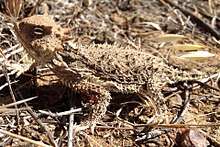Desert horned lizard
| Desert horned lizard | |
|---|---|
 | |
| Scientific classification | |
| Kingdom: | Animalia |
| Phylum: | Chordata |
| Class: | Reptilia |
| Order: | Squamata |
| Suborder: | Iguania |
| Family: | Phrynosomatidae |
| Genus: | Phrynosoma |
| Species: | P. platyrhinos |
| Binomial name | |
| Phrynosoma platyrhinos Girard, 1852 | |
The desert horned lizard (Phrynosoma platyrhinos) is a species of phrynosomatid lizard native to western North America. They are often referred to as "horny toads", although they are not toads, but lizards.
Description
This species of lizard has a distinctive flat body with one row of fringe scales down the sides. They have one row of slightly enlarged scales on each side of the throat. Colours can vary and generally blend in with the color of the surrounding soil, but they usually have a beige, tan, or reddish dorsum with contrasting, wavy blotches of darker color. They have two dark blotches on the neck that are very prominent and are bordered posteriorly by a light white or grey color. They also have pointed scales on the dorsum (back) of the body. Juveniles are similar to adults, but have shorter and less-pronounced cranial spines. Desert horned lizards have horns that are wide at the base, which isn't true for their congener, the short-horned lizard.
Diet
Desert horned lizards prey primarily on invertebrates, such as ants (including red harvester ants,) crickets, grasshoppers, beetles, worms, flies, ladybugs, meal worms and some plant material. They can often be found in the vicinity of ant hills, where they sit and wait for ants to pass by. When they find an area of soft sand, they usually shake themselves vigorously, throwing sand over their backs and leaving only their head exposed. This allows them to hide from predators and await their unsuspecting prey.
Habitat
Found in extremely diverse habitats. The flat-tailed horned lizard occurs in areas of fine sand, while the short-horned lizard (P. douglasii) is found in shortgrass prairie all the way up into spruce-fir forest. The most common species in the Arizona Upland subdivision is the regal horned lizard (P. solare), which frequents rocky or gravelly habitats of arid to semiarid plains, hills and lower mountain slopes.
Geographic range and subspecies
They typically range from southern Idaho in the north to northern Mexico in the south.
There are two subspecies: the northern desert horned lizard (Phrynosoma platyrhinos platyrhinos) ranging in Idaho, Wyoming, Utah, Nevada, the Colorado front range, and parts of southeastern Oregon; and the southern desert horned lizard (Phrynosoma platyrhinos calidiarum) ranging in southern Utah and Nevada to southeast California, western Arizona, and northern Baja California.
Reproduction
The young are called hatchlings. They are about 7/8 to 1-1/8 inches long, snout to vent. The young have been observed to bury themselves in the sand immediately upon hatching. The babies receive no parental care, so when they emerge, they start to hunt for food. The young are cute, the horns on their head are apparent, although the rest of their skin, while well marked, is relatively smooth. Mating occurs in late April, peaks in June and stops abruptly in July. Egg laying starts a few weeks later, usually in late July and early August. The farther north, the later the eggs are laid. In some species the eggs are retained, and the young are hatched just before, during or shortly after laying. Other species bury their eggs in the sand where they require several weeks for further development before the eggs hatch. The egg shells are white and flexible and average about one-half inch in diameter. The number of eggs varies with the species. Some have from 10 to 30 eggs, with an average of about 15. They grow most rapidly in late summer and early spring when there is an abundance of food. There is no evidence that they reproduce the first year, but they are classed as young adults by the end of the second summer and probably reach full growth in three years. Some species reach a snout-to-vent length of 6 inches. Most species are less than 5 inches in length. They have a life expectancy of from 5 to 8 years in the deserts of North America.[2]
Behavior
They are generally a gentle species, but have been known to try to push their cranial spines into the hand while held. When excited, they puff themselves up with air, similar to the way a Chuckwalla does, making themselves look bigger. If spotted near a bush, they will dash into it in an attempt to find cover from any threat. Like several other horned lizard species, desert horned lizards are able to squirt blood from their eyes.[3]
See also
References
- ↑ Hammerson, G.A., Frost, D.R. & Gadsden, H. (2007). Phrynosoma platyrhinos. The IUCN Red List of Threatened Species doi:10.2305/IUCN.UK.2007.RLTS.T64080A12734576.en
- ↑ Horned Lizards. Genus Phrynosoma. desertusa.com
- ↑ Sherbrooke, W.C.; Middendorf III, G.A. (2001). "Blood-Squirting Variability in Horned Lizards (Phrynosoma)" (PDF). Copeia. 2001 (4): 1114–1122. doi:10.1643/0045-8511(2001)001[1114:BSVIHL]2.0.CO;2. JSTOR 1448403.
Further reading
| Wikimedia Commons has media related to Phrynosoma platyrhinos. |
- Hylton, Brodie; Ecology and Species Comparisons of the Short-Horned Lizard (Phrynosoma douglassi) and the Desert Horned Lizard (Phrynosoma platyrhinos), from the following website:
- Arizona-Sonora Desert Museum (http://www.desertmuseum.org/books/nhsd_horned_lizard.php)
